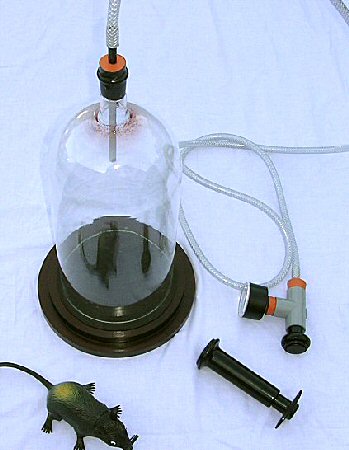

The weight (mass) of the air above is greater the lower we go on earth. In general the pressure will increase below sea level and decrease higher up. Barometers can be used by mountineers to determine height up a mountain and also by pilots to determine the height flying in aircrafts.
The insides of our body are at about the same pressure as the outside so we are generaly unaware of atmospheric pressure but if we quickly go up a hill or down into a valley our bodies take a while to equalise with the corresponding pressure change and so we feel this when our ears 'pop' etc.
The bell jar apparatus is used to create our very own atmosphere contained within the glass jar which for example we can use to explore and understand our larger Earths atmosphere. We have a glass jar that rests on a rubber base which is air tight (seals well). The top of the jar has a bung attached to it through which a metal tube passes. This has a fexible tube attached to it that goes to a hand vacuum pump. I tried various pumps but found that the best hand powered pump was made using a wine preserver.
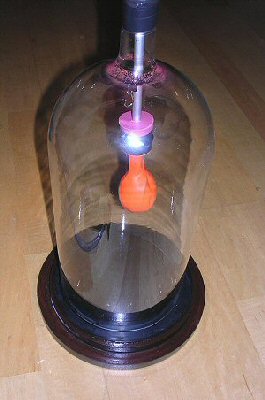
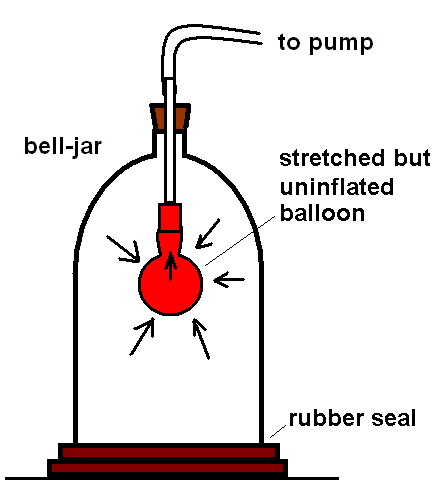 ,
,
You might think that putting a 'super dooper' high tech motor pump will flatten the balloon even more but in fact once you have removed the air from the balloon there is simply no more air to remove. It collapses because of the air pressure outside rather than due to a great 'suck' from the pump. A larger more powerful pump might collapse the balloon quicker but it wont make it any flatter !
As you can only ever take out the air that was in the jar the maximum difference in pressure between the bell-jar and outside can only be about 1 atmophere. As a result explosion (or rather implosion) is possible but unlikely. If you are worried wrapping the jar in cling film and use a perspex (plexyglass) screen between the apparatus and spectators can safe guard aganist accidents.
They didnt have balloons in Newtons day so they used to use animal bladders for these type of experiments - hence the strange name given to this experiment!
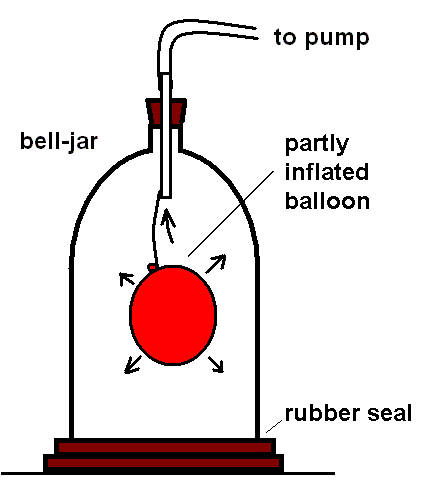
As the pump removes the air from the bell jar the pressure obviously reduces around the balloon. Normally the balloon has this air pressure around it limiting its size, but as this air is removed and the pressure around it reduces the gas in the balloon can expand and so the balloon appears to inflate ! If you let the air back in the bell jar it will shrink back to its original size once more. This is a little bit like what is happening in your body when you go over a hill or down into a valley and your ears 'pop'.
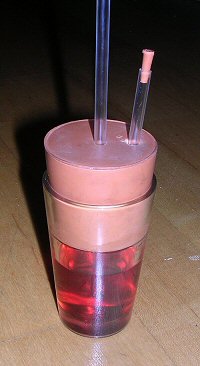 ,
, 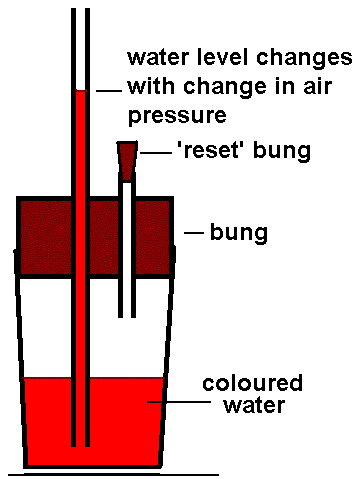
Changes in pressure outside will cause a pressure difference between the tube (open to the air) and the air trapped inside the device to change and this leads to in water level. As the pump removes air from the jar you can see the water level shoot up on the little barometer.
The change in water level 'effect' can help explain why food jars and drinking bottles can leak when travelling around from place to place. The pressure change associated with moving about can cause movement of the contents in and out of badly sealed containers.
Experiment 4 - alarm clock
We hear sounds when they pass across the room and into our ears. Sound travels in waves in the air. Without air we can have no sound (although we can hear a bit by vibrations being transmitted to our ears in solid things such as through our head / bones etc.). So as the movies say "in space no one can hear you scream" because there is no air in the vacuum of space to transfer the sound.
In this experiment we set up a mechanical alarm clock to go off while inside the bell-jar. If we remove a lot of the air in the jar using the pump the alarm ringing will seem very much quieter. The effect is greatest when the very last traces of air are removed but this is often not possible using simple hand pumps so this experiment works best with a motorised pump that can remove the air more effectively.
Experiment 5 - animals need to breath
Hundreds of years ago people were interested the importance of air to life. Now of course we know that you have to breath air (oxygen and nitrogen). They used to take a little bird and place him into the jar and pump out the air until it fell over / fainted. Then they would then let the air back in and the bird would come back to life. Often all this was too much for the poor little bird and it would die in the process : - (
It is debatable how much 'science' was learnt in this process.
back to Newton page
THE CREATIVE SCIENCE CENTRE
home | diary | whats on | CSC summary | latest news